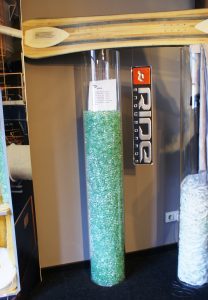Textilglas der Firma Johns Manville – Deutsch/German

„Glas-Pellets“ dienen als Basis für die Glastextilfaserproduktion der Wertheimer Firma Johns Manville – der ehemaligen Firma Schuller Textilglas aus Thüringen. Seit 1952 hat diese ihren Sitz in Wertheim. Mittels Trommelziehverfahren werden die Pellets wieder eingeschmolzen und daraus Glasfasern, Glasfasergarne und Glasfaservliese hergestellt. Diese werden unter anderem weiterverarbeitet als Träger für Bitumendachbahnen und Fußbodenbeläge sowie als Verstärkung für Kunststoffe, vom Snowboard bis hin zum Schiffs- und Eisenbahnbau.
Die Firma Johns Manville in Wertheim schmilzt ihr Glas in Form von Glas-Pellets in zwei modernen Elektrowannenöfen: je etwa 63 Tonnen heißes Glas können dort pro Wanne täglich geschmolzen werden. Nach 6 bis 8 Jahren muss die Wanne mit einer Grundfläche von 25,5 Quadratmetern ausgetauscht werden. Denn mit der Zeit wird die Ummantelung der Wanne aus Feuerfestmaterial immer dünner und es kann flüssiges Glas austreten. Sechs Wochen dauert der „Rebuild“ – der „Wannenwechsel“ von „Glas zu Glas“. Als „Wannenreise“ bezeichnet man die Zeit, in der die Glasschmelzwanne ununterbrochen Glas erschmolzen hat. In dieser Zeit sammelt man Erkenntnisse bezüglich des Feuerfestmaterials und der optimalen „Fahrweise“ der Glaswanne.
Textile Glass from the Johns Manville Company – English

„Glass-Pellets“ provide the basis for the glass fibre products from the Johns Manville company here in Wertheim that used to be Schuller Textile Glass from Thuringia, but moved here in 1952. The pellets are re-melted and the molten glass is passed through bushings, or thread inserts with narrow nozzles that it drips out of and is then drawn into a thread. With this action the drips become glass fibres, fibreglass threads and glass fibre mats. They are then processed into reinforcement for many items including tarred roofing felt, floor coverings, synthetic materials for snowboards, through to items for ship and railway construction.
The Johns Manville Company in Wertheim melts the glass pellets in two modern electric tank furnaces: each with a daily capacity of 63 tons of molten glass. These tank furnaces, with a floor area of 25.5 square metres, have to be replaced every 6 to 8 years because the fireproof cladding becomes thinner and thinner until eventually molten glass could leak through. The rebuild takes 6 weeks. During the tank furnace’s functional lifespan, data is collected to optimise not only the fireproof material, but also the best mode of operation.